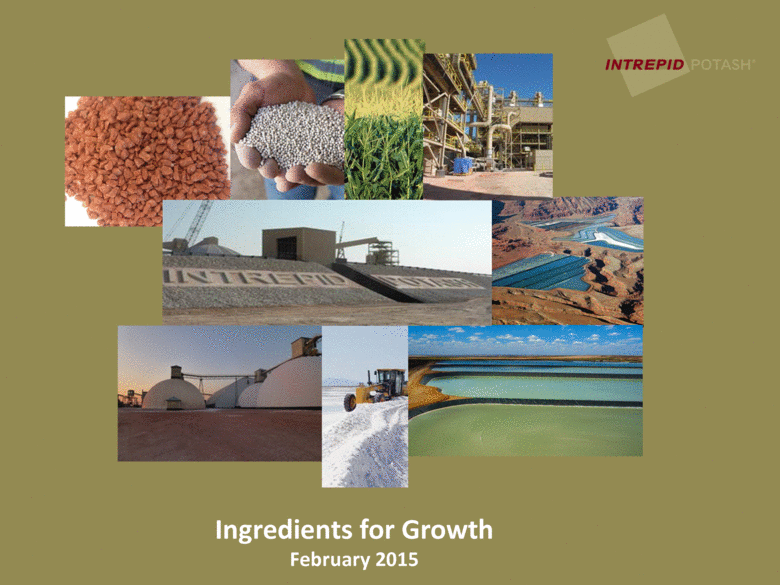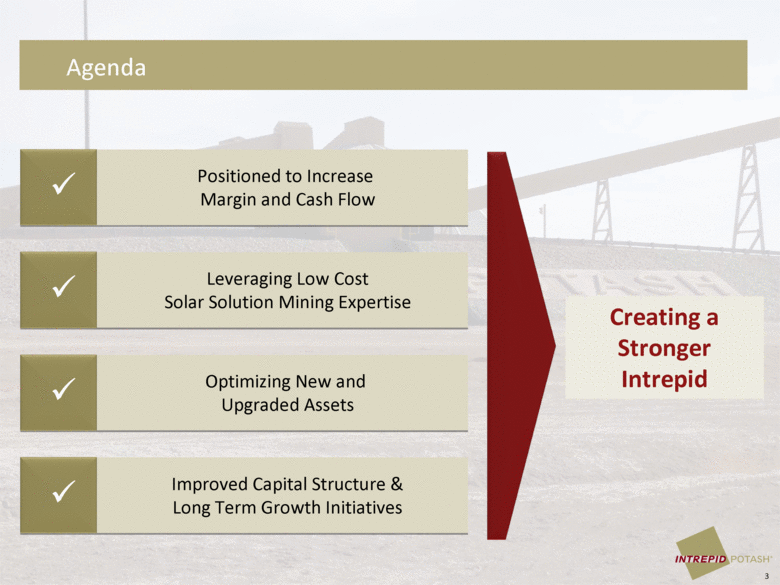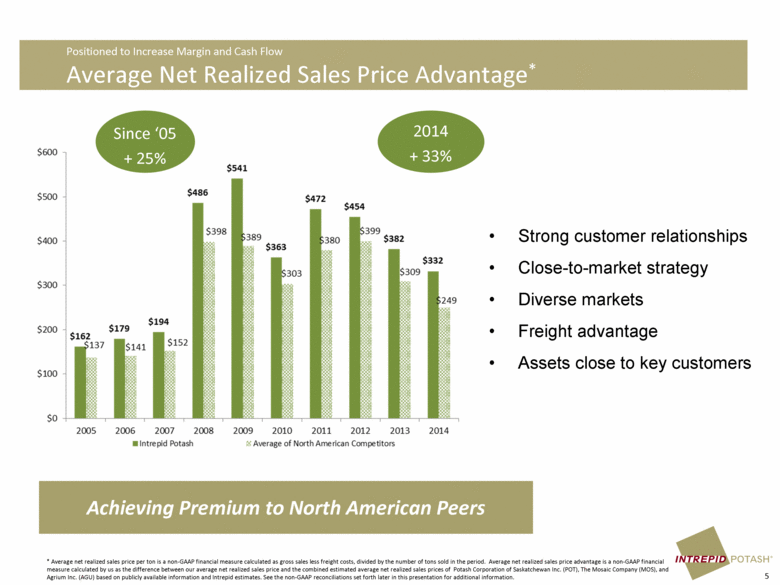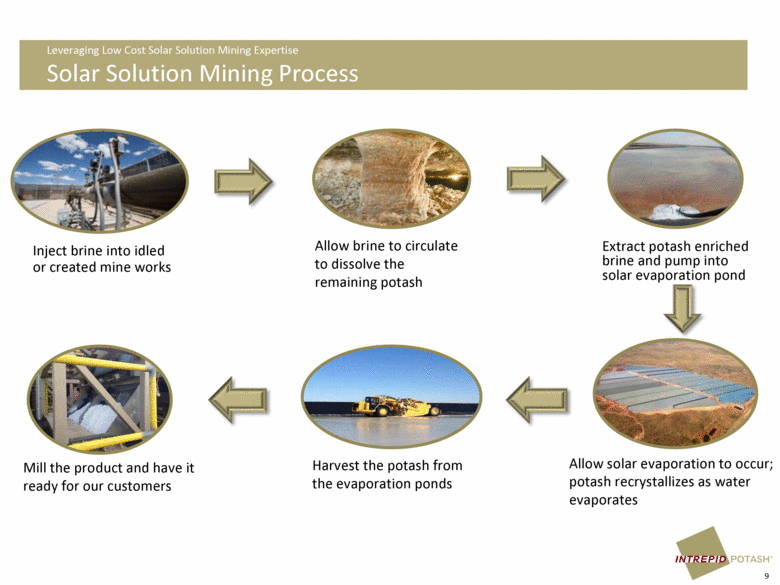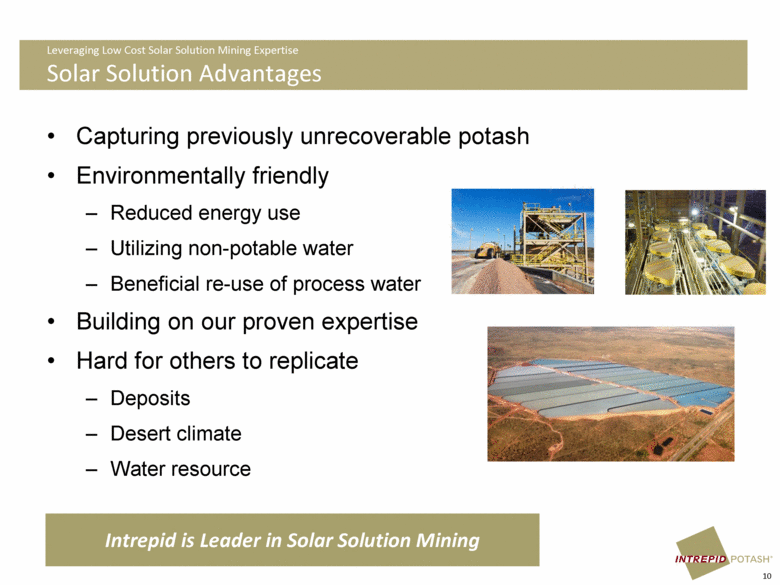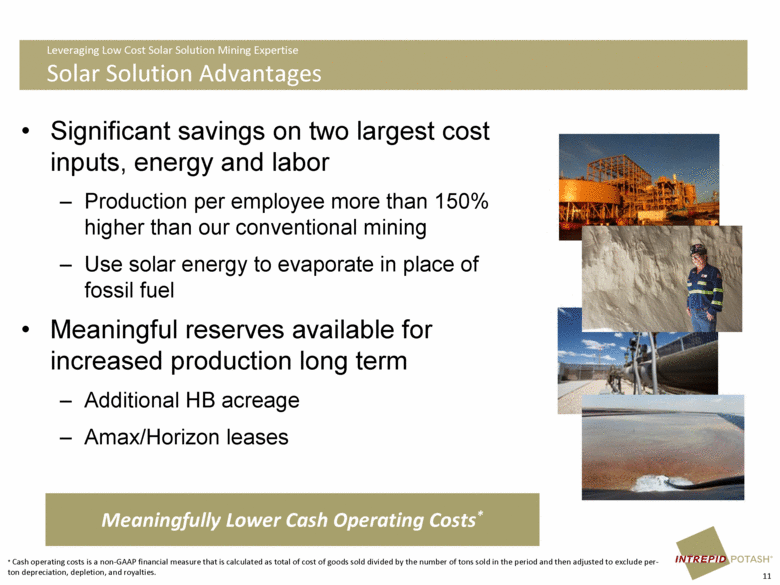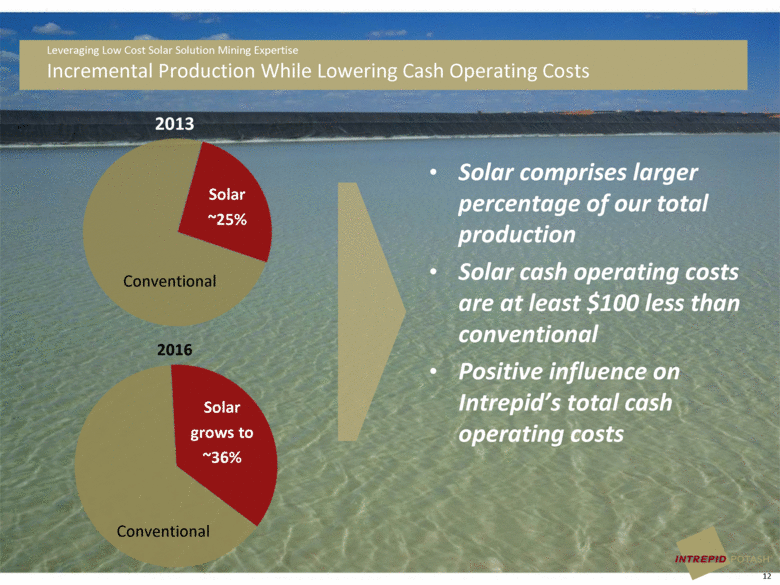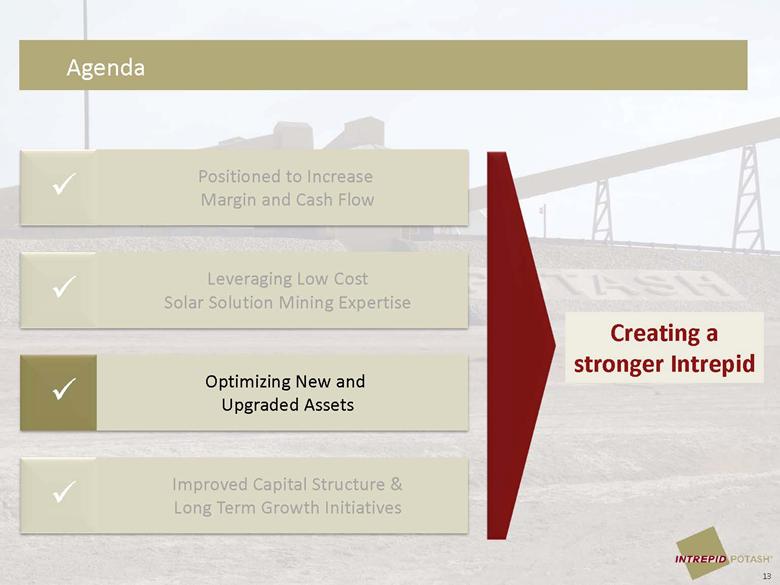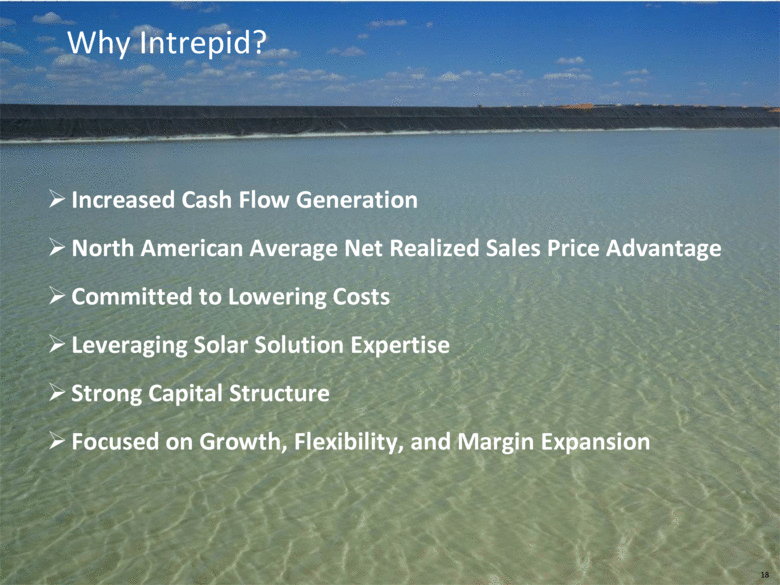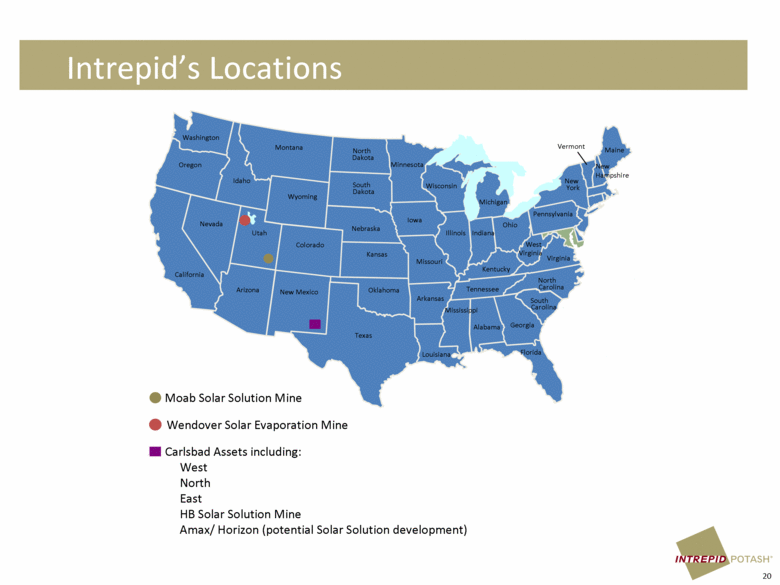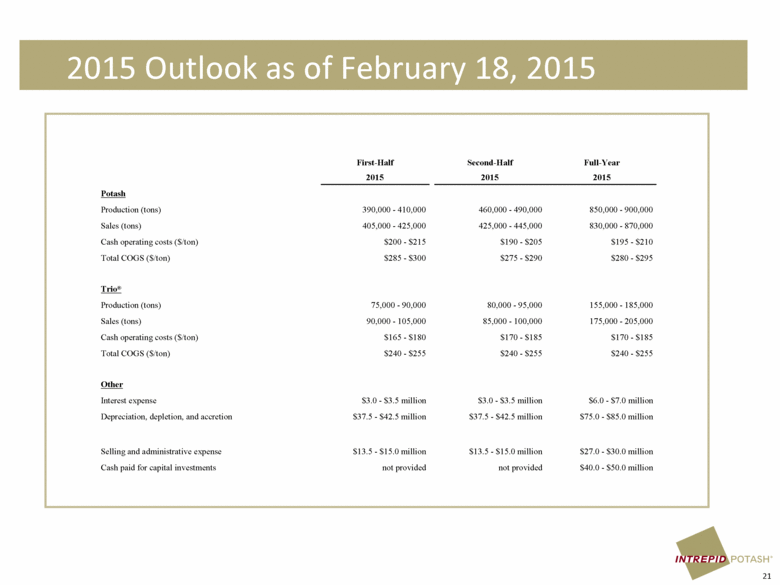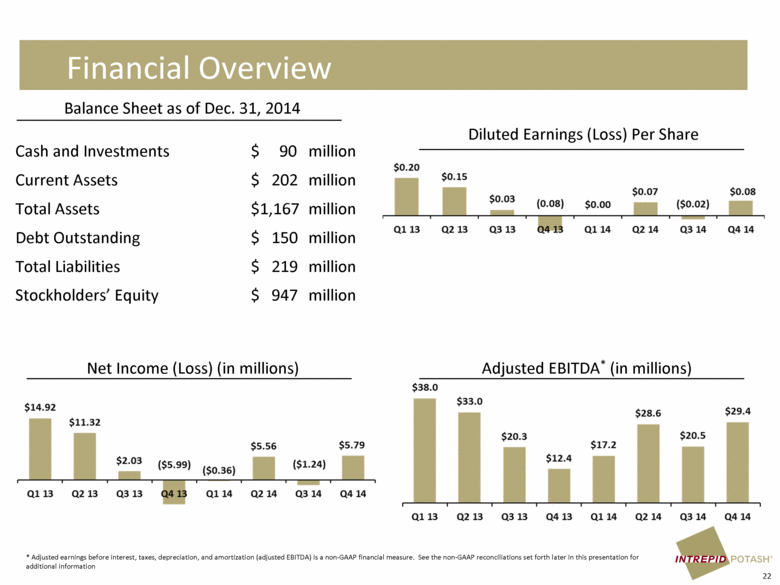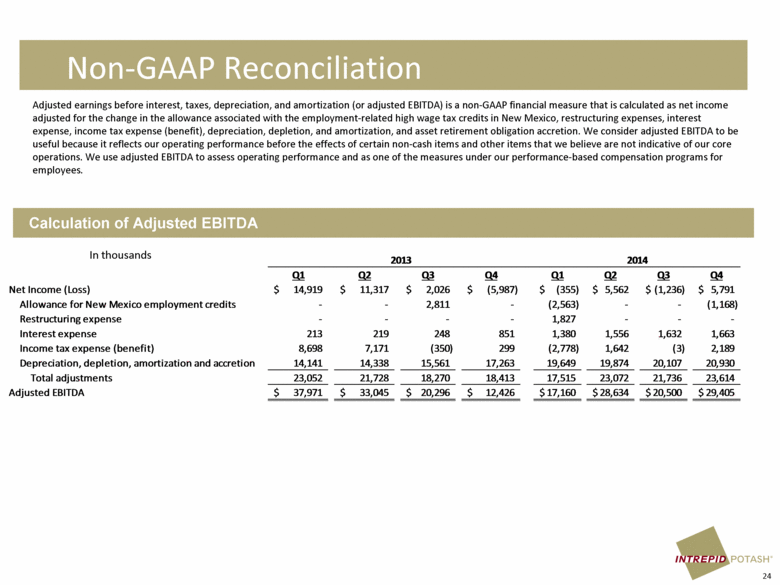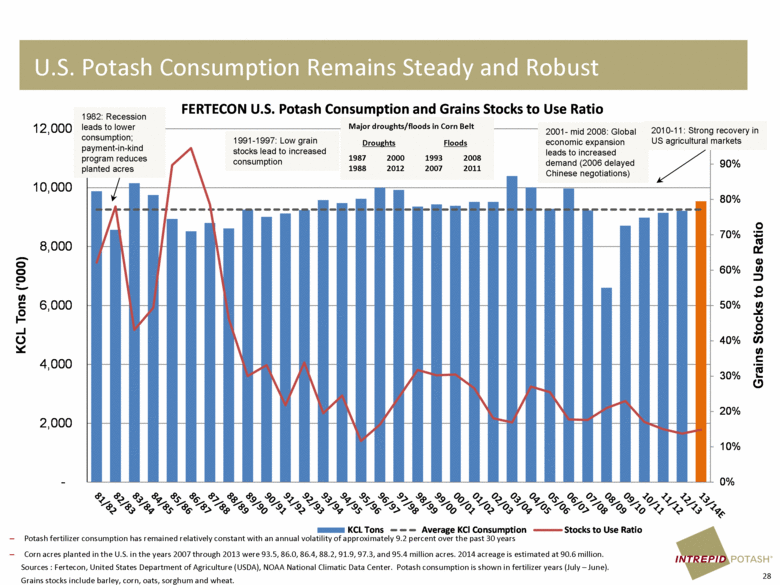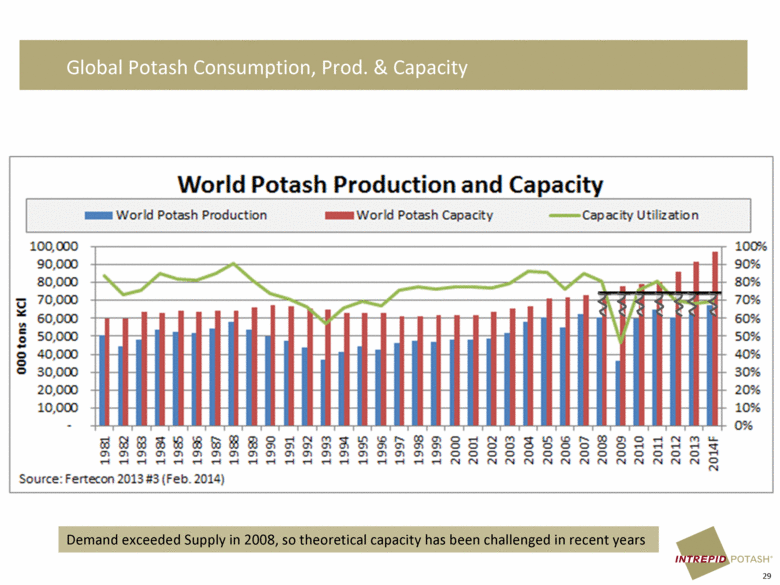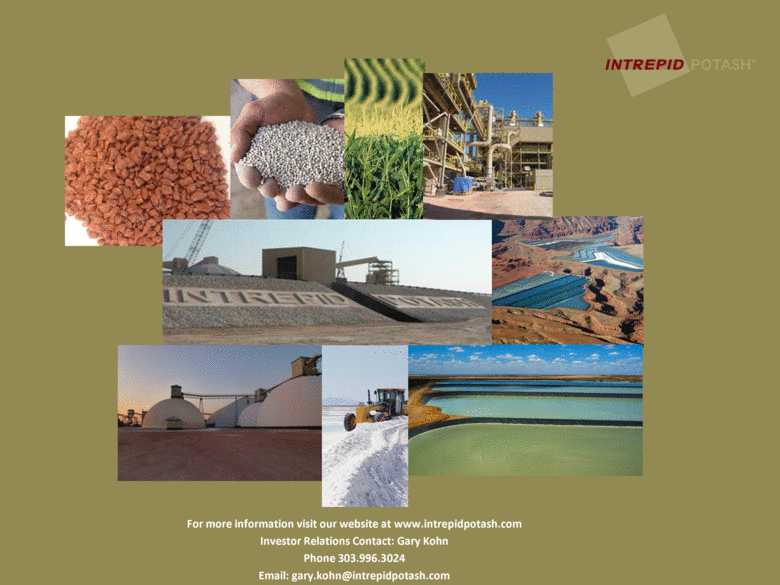Attached files
| file | filename |
|---|---|
| 8-K - 8-K - Intrepid Potash, Inc. | a15-5294_18k.htm |
Exhibit 99.1
|
|
Ingredients for Growth February 2015 |
|
|
This presentation contains forward-looking statements — that is, statements about future, not past, events. These forward-looking statements often relate to our future performance and management’s expectations for the future, including statements about our financial outlook. Our forward-looking statements are based on estimates and assumptions that we believe are reasonable. Actual results could be materially different from our forward-looking statements. The factors that could cause actual results to differ are discussed in our periodic filings with the Securities and Exchange Commission. Statements regarding our financial outlook speak only as of the date of our fourth quarter 2014 earnings release, February 18, 2015, and all other forward-looking statements speak only as of the initial release date of this presentation, February 25, 2015. We have no duty to update publicly or revise any forward-looking statements to conform the statements to actual results or to reflect new information or future events. Safe Harbor 2 |
|
|
Agenda 3 Improved Capital Structure & Long Term Growth Initiatives Creating a Stronger Intrepid Positioned to Increase Margin and Cash Flow Leveraging Low Cost Solar Solution Mining Expertise Optimizing New and Upgraded Assets |
|
|
Agenda 4 Improved Capital Structure & Long Term Growth Initiatives Creating a stronger Intrepid Positioned to Increase Margin and Cash Flow Leveraging Low Cost Solar Solution Mining Expertise Optimizing New and Upgraded Assets |
|
|
Achieving Premium to North American Peers 2014 + 33% * Average net realized sales price per ton is a non-GAAP financial measure calculated as gross sales less freight costs, divided by the number of tons sold in the period. Average net realized sales price advantage is a non-GAAP financial measure calculated by us as the difference between our average net realized sales price and the combined estimated average net realized sales prices of Potash Corporation of Saskatchewan Inc. (POT), The Mosaic Company (MOS), and Agrium Inc. (AGU) based on publicly available information and Intrepid estimates. See the non-GAAP reconciliations set forth later in this presentation for additional information. Positioned to Increase Margin and Cash Flow Average Net Realized Sales Price Advantage* 5 Strong customer relationships Close-to-market strategy Diverse markets Freight advantage Assets close to key customers Since ‘05 + 25% |
|
|
Positioned to Increase Margin and Cash Flow Serving Diverse Markets Strategy is to maximize and sell all of our production Flexibility to react to changes in demand Selling into the highest margin opportunities Participation in specialty market – Trio® Potash Sales Mix Industrial Agricultural Animal Feed 6 Maximizing Price and Margin |
|
|
Balanced fertilization essential to maximizing yields Operating in markets that consume many multiples of Intrepid's production Favorable demand trends from 2014 continued into 2015 7 Positioned to Increase Margin and Cash Flow Strong Industry Fundamentals Record Sales for Intrepid in 2014 Strong potash demand and stable pricing through spring application Demand exceeding supply for Trio® driving pricing |
|
|
Agenda 8 Improved Capital Structure & Long Term Growth Initiatives Creating a stronger Intrepid Positioned to Increase Margin and Cash Flow Leveraging Low Cost Solar Solution Mining Expertise Optimizing New and Upgraded Assets |
|
|
Leveraging Low Cost Solar Solution Mining Expertise Solar Solution Mining Process Inject brine into idled or created mine works Allow brine to circulate to dissolve the remaining potash Extract potash enriched brine and pump into solar evaporation pond Allow solar evaporation to occur; potash recrystallizes as water evaporates Harvest the potash from the evaporation ponds Mill the product and have it ready for our customers 9 |
|
|
Leveraging Low Cost Solar Solution Mining Expertise Solar Solution Advantages 10 Capturing previously unrecoverable potash Environmentally friendly Reduced energy use Utilizing non-potable water Beneficial re-use of process water Building on our proven expertise Hard for others to replicate Deposits Desert climate Water resource Intrepid is Leader in Solar Solution Mining |
|
|
Leveraging Low Cost Solar Solution Mining Expertise Solar Solution Advantages 11 Significant savings on two largest cost inputs, energy and labor Production per employee more than 150% higher than our conventional mining Use solar energy to evaporate in place of fossil fuel Meaningful reserves available for increased production long term Additional HB acreage Amax/Horizon leases Meaningfully Lower Cash Operating Costs* * Cash operating costs is a non-GAAP financial measure that is calculated as total of cost of goods sold divided by the number of tons sold in the period and then adjusted to exclude per-ton depreciation, depletion, and royalties. |
|
|
Conventional Solar ~25% Leveraging Low Cost Solar Solution Mining Expertise Incremental Production While Lowering Cash Operating Costs 12 2013 Conventional Solar grows to ~36% 2016 Solar comprises larger percentage of our total production Solar cash operating costs are at least $100 less than conventional Positive influence on Intrepid’s total cash operating costs |
|
|
Agenda 13 Improved Capital Structure & Long Term Growth Initiatives Creating a stronger Intrepid Positioned to Increase Margin and Cash Flow Leveraging Low Cost Solar Solution Mining Expertise Optimizing New and Upgraded Assets |
|
|
OBJECTIVE Respond to changing demand to pursue highest margin sales Ability to compact 100% of potash Sell more Premium Trio® PROJECTS North compaction Trio® pellet plant OBJECTIVE Increase production Lower costs PROJECTS HB Solar Solution mine Moab solution mining caverns West plant improvements GROWTH OBJECTIVE Lower per ton cash operating costs PROJECTS HB Solar Solution mine North compaction West recovery improvement MARGIN 14 Optimizing New and Upgraded Assets Completed Projects Driving Flexibility, Growth and Margin |
|
|
Agenda 15 Improved Capital Structure & Long Term Growth Initiatives Creating a stronger Intrepid Positioned to Increase Margin and Cash Flow Leveraging Low Cost Solar Solution Mining Expertise Optimizing New and Upgraded Assets |
|
|
Cash and investments totaling $90 million $250 unsecured credit facility in place through August 2018 $150 million in unsecured long-term debt, average interest rate under 4% First maturity is $60 million in 2020 Generated positive free cash flow* in 2014 Cash flow from operations $127 million Cash used for capital expenditures $62 million Goal to continue generating free cash flow CAPEX projected to be $40-$50 million in 2015 Improved Capital Structure & Long Term Growth Initiatives Balance Sheet Strength Dec. 31, 2014 16 * Free cash flow is a non GAAP measure that is calculated as net cash provided by operating activities less cash paid for capital expenditures. |
|
|
OBJECTIVE Incremental solar solution production Lower cash operating costs PROJECTS Additional phases of HB Amax/Horizon Increase Solar Solution Production OBJECTIVE Produce more Trio® PROJECTS Recovery improvements Premium conversion process Grow Trio® Sales OBJECTIVE Lower per ton cash operating costs PROJECTS Process improvements and enhancements Improve Conventional Mining Efficiencies Improved Capital Structure & Long Term Growth Initiatives Long Term Growth Focus 17 |
|
|
Why Intrepid? Increased Cash Flow Generation North American Average Net Realized Sales Price Advantage Committed to Lowering Costs Leveraging Solar Solution Expertise Strong Capital Structure Focused on Growth, Flexibility, and Margin Expansion 18 |
|
|
Appendix ® Supplying a Growing America® Appendix |
|
|
Intrepid’s Locations 20 Moab Solar Solution Mine Carlsbad Assets including: West North East HB Solar Solution Mine Amax/ Horizon (potential Solar Solution development) Florida New Mexico Texas Oklahoma Kansas Nebraska South Dakota Montana Wyoming Colorado Utah Idaho Arizona Nevada Washington California Oregon Kentucky Maine New York Pennsylvania Michigan Vermont New Hampshire Virginia West Virginia Ohio Indiana Illinois North Carolina Tennessee South Carolina Alabama Mississippi Arkansas Louisiana Missouri Iowa Minnesota Wisconsin Georgia North Dakota |
|
|
2015 Outlook as of February 18, 2015 21 First-Half Second-Half Full-Year 2015 2015 2015 Potash Production (tons) 390,000 - 410,000 460,000 - 490,000 850,000 - 900,000 Sales (tons) 405,000 - 425,000 425,000 - 445,000 830,000 - 870,000 Cash operating costs ($/ton) $200 - $215 $190 - $205 $195 - $210 Total COGS ($/ton) $285 - $300 $275 - $290 $280 - $295 Trio® Production (tons) 75,000 - 90,000 80,000 - 95,000 155,000 - 185,000 Sales (tons) 90,000 - 105,000 85,000 - 100,000 175,000 - 205,000 Cash operating costs ($/ton) $165 - $180 $170 - $185 $170 - $185 Total COGS ($/ton) $240 - $255 $240 - $255 $240 - $255 Other Interest expense $3.0 - $3.5 million $3.0 - $3.5 million $6.0 - $7.0 million Depreciation, depletion, and accretion $37.5 - $42.5 million $37.5 - $42.5 million $75.0 - $85.0 million Selling and administrative expense $13.5 - $15.0 million $13.5 - $15.0 million $27.0 - $30.0 million Cash paid for capital investments not provided not provided $40.0 - $50.0 million |
|
|
Financial Overview Adjusted EBITDA* (in millions) Balance Sheet as of Dec. 31, 2014 Net Income (Loss) (in millions) Diluted Earnings (Loss) Per Share Cash and Investments $ 90 million Current Assets $ 202 million Total Assets $1,167 million Debt Outstanding $ 150 million Total Liabilities $ 219 million Stockholders’ Equity $ 947 million 22 * Adjusted earnings before interest, taxes, depreciation, and amortization (adjusted EBITDA) is a non-GAAP financial measure. See the non-GAAP reconciliations set forth later in this presentation for additional information |
|
|
Non-GAAP Reconciliations To supplement our consolidated financial statements, which are prepared and presented in accordance with GAAP, we use several non-GAAP financial measures to monitor and evaluate our performance. These non-GAAP financial measures may include adjusted net income (loss), adjusted net income (loss) per diluted share, adjusted EBITDA, net sales, average net realized sales price, cash operating costs, average potash and Trio® gross margin, cash flow per ton and free cash flow. These non-GAAP financial measures should not be considered in isolation or as a substitute for, or superior to, the financial information prepared and presented in accordance with GAAP. In addition, because the presentation of these non-GAAP financial measures varies among companies, our non-GAAP financial measures may not be comparable to similarly titled measures used by other companies. We believe these non-GAAP financial measures provide useful information to investors for analysis of our business. We also refer to these non-GAAP financial measures in assessing our performance and when planning, forecasting and analyzing future periods. We believe these non-GAAP financial measures are widely used by professional research analysts and others in the valuation, comparison and investment recommendations of companies in the potash mining industry. Many investors use the published research reports of these professional research analysts and others in making investment decisions. Below is additional information about our non-GAAP financial measures, including, if applicable, reconciliations of our non-GAAP financial measures to the most directly comparable GAAP measures: 23 |
|
|
Non-GAAP Reconciliation Calculation of Adjusted EBITDA Adjusted earnings before interest, taxes, depreciation, and amortization (or adjusted EBITDA) is a non-GAAP financial measure that is calculated as net income adjusted for the change in the allowance associated with the employment-related high wage tax credits in New Mexico, restructuring expenses, interest expense, income tax expense (benefit), depreciation, depletion, and amortization, and asset retirement obligation accretion. We consider adjusted EBITDA to be useful because it reflects our operating performance before the effects of certain non-cash items and other items that we believe are not indicative of our core operations. We use adjusted EBITDA to assess operating performance and as one of the measures under our performance-based compensation programs for employees. 24 In thousands 2013 2014 Q1 Q2 Q3 Q4 Q1 Q2 Q3 Q4 Net Income (Loss) 14,919 $ 11,317 $ 2,026 $ (5,987) $ (355) $ 5,562 $ (1,236) $ 5,791 $ Allowance for New Mexico employment credits - - 2,811 - (2,563) - - (1,168) Restructuring expense - - - - 1,827 - - - Interest expense 213 219 248 851 1,380 1,556 1,632 1,663 Income tax expense (benefit) 8,698 7,171 (350) 299 (2,778) 1,642 (3) 2,189 Depreciation, depletion, amortization and accretion 14,141 14,338 15,561 17,263 19,649 19,874 20,107 20,930 Total adjustments 23,052 21,728 18,270 18,413 17,515 23,072 21,736 23,614 Adjusted EBITDA 37,971 $ 33,045 $ 20,296 $ 12,426 $ 17,160 $ 28,634 $ 20,500 $ 29,405 $ |
|
|
Non-GAAP Reconciliation Net sales, average net realized sales price, and average net realized sales price advantage are non-GAAP financial measures. Net sales are calculated as sales less freight costs. Average net realized sales price is calculated as net sales, divided by the number of tons sold in the period. Average net realized sales price advantage is calculated by us as the difference between our average net realized sales price and the combined estimated average net realized sales prices of Potash Corporation of Saskatchewan Inc. (POT), The Mosaic Company (MOS), and Agrium Inc. (AGU) based on publicly available information. We consider these measures to be useful because they remove the effect of transportation and delivery costs on sales and pricing. When we arrange transportation and delivery for a customer, we include in revenue and in freight costs the costs associated with transportation and delivery. However, many of our customers arrange for and pay their own transportation and delivery costs, in which case these costs are not included in our revenue and freight costs. We use these measures as key performance indicators to analyze sales and price trends. We also use net sales as one of the measures under our performance-based compensation programs for employees. 25 Net Sales, Average Net Realized Sales Price, and Average Net Realized Sales Price Advantage In thousands, except per ton amounts Potash: Year Ended December 31, 2005 2006 2007 2008 2009 2010 2011 2012 2013 2014 Sales 150,381 $ 138,482 $ 188,006 $ 362,703 $ 250,887 $ 312,088 $ 392,331 $ 402,382 $ 284,831 $ 334,323 $ Freight costs 9,261 8,122 14,271 10,318 13,060 18,021 18,470 21,396 20,796 30,615 Net sales 141,120 130,360 173,735 352,385 237,827 294,067 373,861 380,986 264,035 303,708 Divided by: Tons sold (in thousands) 869 729 893 724 440 810 793 839 692 915 Average net realized sales price per ton 162 $ 179 $ 194 $ 486 $ 541 $ 363 $ 472 $ 454 $ 382 $ 332 $ Estimated average net realized sales price per ton of North American competitors (POT, MOS, AGU) 137 $ 141 $ 152 $ 398 $ 389 $ 303 $ 380 $ 399 $ 309 $ 249 $ Average net realized sales price advantage 25 $ 38 $ 42 $ 88 $ 152 $ 60 $ 92 $ 55 $ 73 $ 83 $ Average net realized sales price advantage expressed as a percentage 18% 27% 28% 22% 39% 20% 24% 14% 24% 33% |
|
|
Non-GAAP Reconciliation Free Cash Flow Free cash flow is a non-GAAP financial measure that is calculated as net cash provided by operating activities less cash paid for capital expenditures. We consider free cash flow to be a useful measure of liquidity because it indicates cash generated by normal business operations, including capital expenditures. Free cash flow does not represent cash available for discretionary expenditures because we have non-discretionary obligations, such as debt service obligations, that are not deducted from this measure. 26 Free Cash Flow In thousands, except per ton amounts Free Cash Flow 2014 2013 Net cash provided by operating activities 127,486 64,898 Less cash paid for additions to property, plant, equipment and mineral properties (61,770) (250,485) Free cash flow 65,716 (185,587) Net cash used in investing activities (a) (59,624) (246,439) Net cash (used in) provided by financing activities (667) 148,316 (a) Includes cash paid for additions to property, plant, equipment and mineral properties Year Ended December 31, |
|
|
Historical Quarterly Production and Sales 27 Note: One short ton equals 2,000 pounds. One metric tonne, which many international competitors use, equals 1,000 kilograms or 2,204.62 pounds. |
|
|
U.S. Potash Consumption Remains Steady and Robust Sources : Fertecon, United States Department of Agriculture (USDA), NOAA National Climatic Data Center. Potash consumption is shown in fertilizer years (July – June). Grains stocks include barley, corn, oats, sorghum and wheat. Potash fertilizer consumption has remained relatively constant with an annual volatility of approximately 9.2 percent over the past 30 years Corn acres planted in the U.S. in the years 2007 through 2013 were 93.5, 86.0, 86.4, 88.2, 91.9, 97.3, and 95.4 million acres. 2014 acreage is estimated at 90.6 million. 1982: Recession leads to lower consumption; payment-in-kind program reduces planted acres 1991-1997: Low grain stocks lead to increased consumption 2001- mid 2008: Global economic expansion leads to increased demand (2006 delayed Chinese negotiations) 2010-11: Strong recovery in US agricultural markets Major droughts/floods in Corn Belt Droughts Floods 1987 1988 2000 2012 1993 2007 2008 2011 28 0% 10% 20% 30% 40% 50% 60% 70% 80% 90% 100% - 2,000 4,000 6,000 8,000 10,000 12,000 Grains Stocks to Use Ratio KCL Tons ('000) FERTECON U.S. Potash Consumption and Grains Stocks to Use Ratio KCL Tons Average KCl Consumption Stocks to Use Ratio |
|
|
Global Potash Consumption, Prod. & Capacity Demand exceeded Supply in 2008, so theoretical capacity has been challenged in recent years 29 |
|
|
Global Industry Susceptible to Production Interruption and Supply “Shocks” Depleted Conventional Mines Mines Currently With Less than 15 Years Reserve Life Theodore, Amelie, Marie Louis mines- France Pasquasi and San Cataldo mines - Italy Salzdetfurth, Friedrichshall, Bergmannssegen-Hugo, Siegfried-Giesen, and Niedersachen-Riedel - Germany Trona, California Horizon-Amax, Wills-Weaver, Saunders – Carlsbad, New Mexico Carlsbad, NM, United States – Mosaic*, closed Hersey, United States – Mosaic*, closed Boulby, England – ICL Soligorsk I, Belarussia - Belaruskali Taquari, Brazil – Vale Sigmundshall – K + S *Mosaic ceased MOP production at both Hersey and Carlsbad in 2014, though it still produces a langbeinite product in Carlsbad. sources: Fertecon, Intrepid Potash®, and public filings Mine Closures Due to Water Inflows PCA (Patience Lake) (0.8MM tons KCl / yr) Potacan mine (0.8MM tons KCl / yr) Mines with Water Inflows K2 Mine Esterhazy Produced 4 million tons KCl in 2013 Most recent 10-K indicated more than $200 million cost abd capital to mitigate in 2014 PCS New Brunswick Mine Produced 0.8 million tons KCl in 2012 Being replaced with a 2 million ton mine by 2015 Belaruskali Mine #2 Capacity to produce 2.5 million tons KCl per year St. Paul mine (Congo) (0.8MM tons KCl / yr) Berezniki I (1.3MM tons KCl / yr) Berezniki 3 mine (1.8MM tons KCl / yr) Mine Closures Due to Depletion Due to geology, in the 70 plus years of potash mining in the Carlsbad area, there has never been a mine lost to flooding or a water incursion 30 Solikamsk -2 (2 MM tons/yr) production suspended in November 2014 |
|
|
Fundamentals of Increasing Population Continue to Drive Grain and Ultimately Potash Demand Over the Long Term Note: Grains include corn, wheat, barley, oats and sorghum. Stocks-to-use ratio is ending inventory / consumption for that crop year; data updated monthly. Sources: United Nations Food and Agriculture Organization (FAO), World Bank, US Census Bureau, USDA, Potash & Phosphate Institute (PPI,) International Fertilizer Industry Association (IFA), Fertecon (1) Futures prices based on closing price of Chicago Board of Trade futures contracts as of 2/23/2015; futures prices for November/December delivery in forecast years. Hectares of Arable Land per Person Hectares per person Crop Prices Over Time(1) World Grain Production and Stocks-to-Use Ratios Grain Production Stocks-to-Use Ratio 5 Year Average Fall 2015 Futures Soybeans: $12.41 $9.80 Wheat: $6.71 $5.30 Corn: $5.38 $4.10 Grain Production (Millions of Tons) Stocks-to-Use Ratio Trend line Population Growth vs. Potash Demand 31 Global population Global Potash Consumption - 1 2 3 4 5 6 7 8 - 10 20 30 40 50 60 70 80 1981 1983 1985 1987 1989 1991 1993 1995 1997 1999 2001 2003 2005 2007 2009 2011 2013 Global Midyear Population (in billions) million tons KCl equivalent Collapse of Soviet Union 2008 Global Financial Crisis 0.39 0.33 0.29 0.25 0.22 0.21 0.20 0.18 0.17 0.00 0.05 0.10 0.15 0.20 0.25 0.30 0.35 0.40 1970 1980 1990 2000 2010 2020F 2030F 2040F 2050F 10% 20% 30% 40% 50% 600 800 1,000 1,200 1,400 1,600 1,800 2,000 2,200 1980 1982 1984 1986 1988 1990 1992 1994 1996 1998 2000 2002 2004 2006 2008 2010 2012 2014F |
|
|
For more information visit our website at www.intrepidpotash.com Investor Relations Contact: Gary Kohn Phone 303.996.3024 Email: gary.kohn@intrepidpotash.com |

